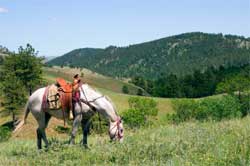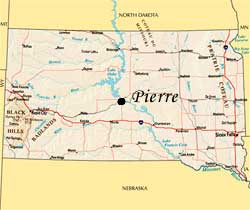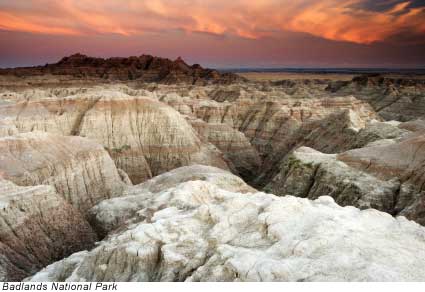
 In 1743, the Verendrye brothers claimed the region that is now South Dakota for France. Today, the state's capital is Pierre. The discovery of gold in 1874 in the Black Hills caused prospectors to rush to the state. Mining towns like Deadwood and Lead attracted a lot of outlaws and other people, like Wild Bill Hickok, Seth Bullock, and Calamity Jane. You can visit the graves of Wild Bill Hickok and sharp-shooting, fast-riding, Old West heroin Calamity Jane in Deadwood. Today, South Dakota is a leading gold-producing state, most of which comes from the extremely rich Homestake Mine in the Black Hills. In 1743, the Verendrye brothers claimed the region that is now South Dakota for France. Today, the state's capital is Pierre. The discovery of gold in 1874 in the Black Hills caused prospectors to rush to the state. Mining towns like Deadwood and Lead attracted a lot of outlaws and other people, like Wild Bill Hickok, Seth Bullock, and Calamity Jane. You can visit the graves of Wild Bill Hickok and sharp-shooting, fast-riding, Old West heroin Calamity Jane in Deadwood. Today, South Dakota is a leading gold-producing state, most of which comes from the extremely rich Homestake Mine in the Black Hills.
North Dakota and South Dakota are known as "twin states" because they were admitted to the Union on the same day, November 2, 1889. No one knows which state was admitted first because President Benjamin Harrison purposely shuffled and then blindly signed the papers. Alphabetically, North Dakota is recognized as the 39th state and South Dakota the 40th. However, the states aren't identical twins. They have similar shapes, sizes, and climates, but differ in many other ways.
Dakota is a Sioux Indian word for "friend" or "ally." South Dakota's largest city is Sioux Falls. The coyote is the state animal and the state is sometimes called the "Coyote State." The abbreviation for South Dakota is SD.

 South Dakota is a West North Central state bordered by North Dakota to the north, Minnesota and Iowa to the east, Nebraska to the south, and Montana and Wyoming to the west. The Missouri River runs through the center of the state. The state's western region is part of the Great Plains. It has deep canyons and rolling plains. The state's eastern region is more like the Midwest. It has low hills, lakes formed by very old glaciers, and large areas of fertile farmland. There are Badlands in South Dakota's southwestern region. Badlands are areas of small, steep hills and deep gullies formed primarily by water erosion. The state also has grasslands and prairies. Because of its extremely varied landscape, South Dakota is sometimes called the "Land of Infinite Variety." South Dakota is a West North Central state bordered by North Dakota to the north, Minnesota and Iowa to the east, Nebraska to the south, and Montana and Wyoming to the west. The Missouri River runs through the center of the state. The state's western region is part of the Great Plains. It has deep canyons and rolling plains. The state's eastern region is more like the Midwest. It has low hills, lakes formed by very old glaciers, and large areas of fertile farmland. There are Badlands in South Dakota's southwestern region. Badlands are areas of small, steep hills and deep gullies formed primarily by water erosion. The state also has grasslands and prairies. Because of its extremely varied landscape, South Dakota is sometimes called the "Land of Infinite Variety."

South Dakota is primarily an agricultural state. Farms and ranches cover about 90 percent of the state's land. In fact, farming is more important to South Dakota's economy than that of any other state. The state's agricultural products include oats, hay, flaxseed, and corn. Service industries including education, health care, banking, and trade are also important.

Tourism is another important part of South Dakota's economy. The industry's growth has created new jobs and income. The Black Hills, home of Mount Rushmore, are one of the most popular tourist attractions in the country. Mount Rushmore, one of the world's largest sculptures, is a spectacular carving of the busts of Presidents George Washington, Thomas Jefferson, Theodore Roosevelt, and Abraham Lincoln in the granite face of the mountain. South Dakota is sometimes called the "Mount Rushmore State." A gigantic sculpture of Crazy Horse, a famous Sioux Indian chief, is being carved in the Black Hills near the town of Custer. That sculpture is going to be even bigger than Mount Rushmore. You can see fantastic rock formations of spires, canyons, pinnacles, and ridges at Badlands National Park.

|